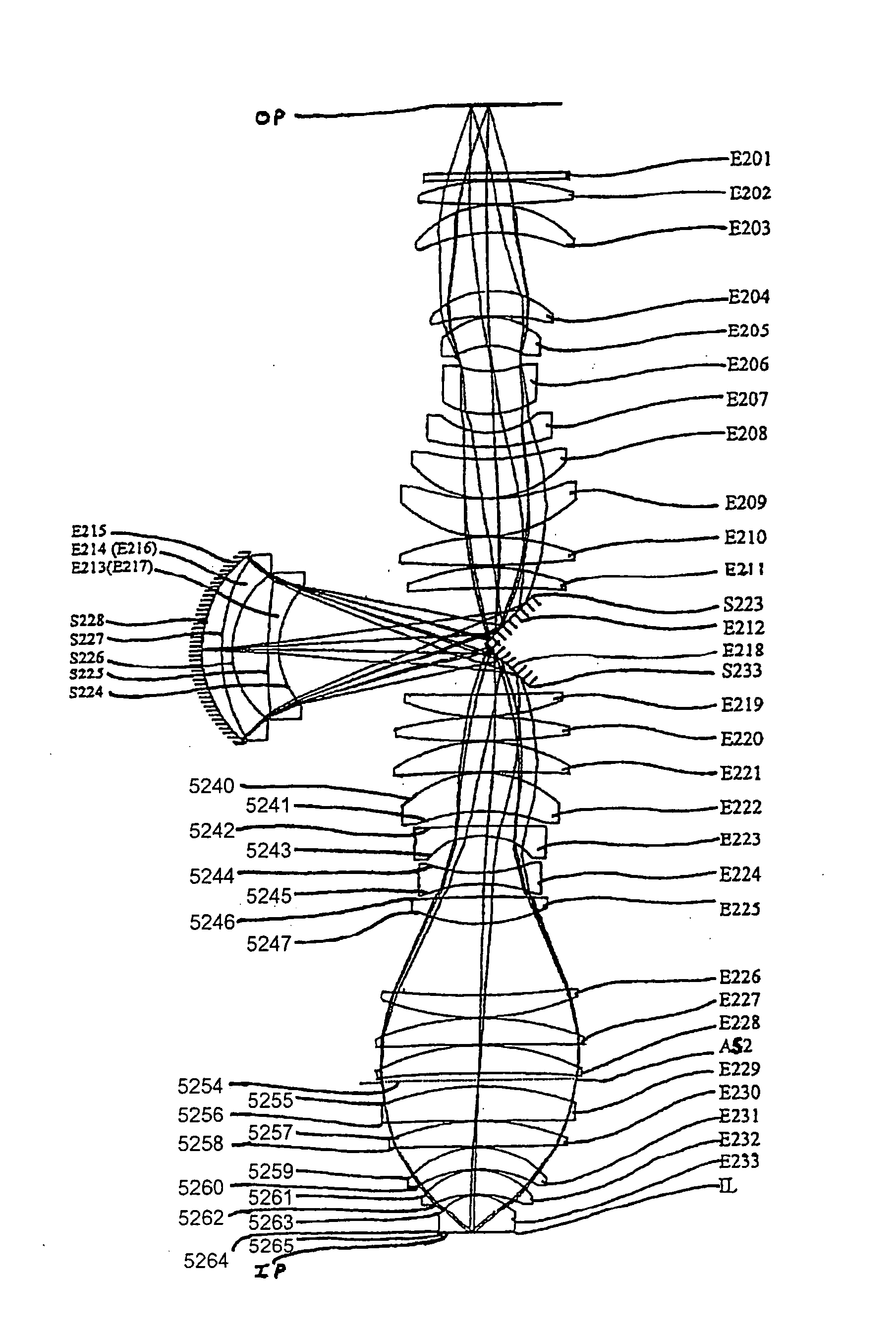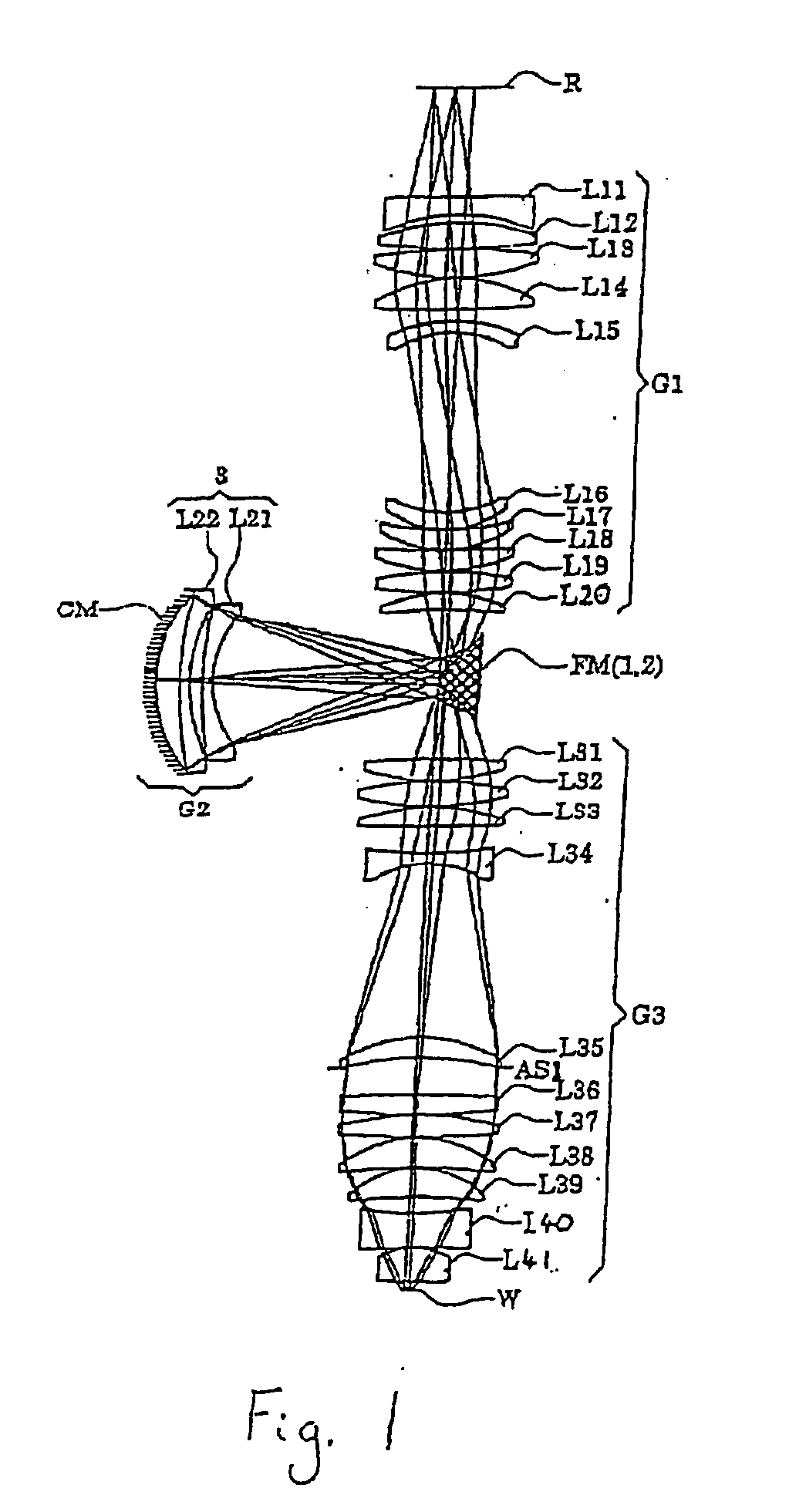Projection optical system and method for photolithography and exposure apparatus and method using same
a technology of projection optical system and exposure apparatus, which is applied in the field of projection optical system, can solve the problems of increasing the reflection loss on the optical plane, slow production, and inability to ensure a large and effective numerical aperture on the image side, and achieves the effect of large and effective image-side numerical aperture, high efficiency, and inhibiting satisfactorily the reflection loss on the optical surfa
- Summary
- Abstract
- Description
- Claims
- Application Information
AI Technical Summary
Benefits of technology
Problems solved by technology
Method used
Image
Examples
fourth embodiment
[0145] The exposure apparatus of this embodiment has a configuration in which, from among the optical members forming the projection optical system PL, the interior of the projection optical system PL is kept in an air-tight state between the optical member arranged at a position the closest to the reticle (in the fourth embodiment, the lens L11) and the boundary lens Lb arranged at a position the closest to the wafer W. The gas in the projection optical system PL is substituted by an inert gas such as helium gas or nitrogen or kept substantially in a vacuum state. The reticle R, the reticle stage RS and the like are arranged in a narrow optical path between the illuminating optical system IL and the projection optical system PL. The inert gas such as nitrogen or helium gas is filled in the interior of a casing (not shown) hermetically enclosing the reticle R, the reticle stage RS and the like, or the interior is maintained substantially in a vacuum state.
[0146]FIG. 10 schematically...
second embodiment
[0156] In the second embodiment, an ArF excimer laser source is used as a light source 100. Quartz (SiO2) is used for all the refracting optical members (lens components) forming the projection optical system PL and the parallel flat sheet Lp. The ArF excimer laser beam which is the exposure light has an oscillation center wavelength of 193.306 nm, and quartz has a refractive index of 1.5603261 for this center wavelength. Deionized water having a refractive index of 1.47 for the exposure light is used as the medium Lm present between the boundary lens Lb and the wafer W.
[0157] In the projection optical system PL in the second embodiment, the first image forming optical system G1 comprises, sequentially from the reticles side, a positive meniscus lens L11 with a convex face thereof directed toward the reticle; a biconvex lens L12 with an aspherical convex surface or face thereof directed toward the wafer; a positive meniscus lens L13 with a convex surface thereof directed toward the ...
third embodiment
[0169] In the projection optical system PL of the third embodiment, the first image forming optical system G1 comprises, sequentially from the reticle side, a positive meniscus lens L11 with a convex surface thereof directed toward the reticle; a biconvex lens L12 with an aspherical convex surface thereof directed toward the wafer; a positive meniscus lens L13 with a convex surface thereof directed toward the reticle; a positive meniscus lens L14 with a concave surface thereof directed toward the reticle; a negative meniscus lens 115 with a concave surface thereof directed toward the reticle; a negative meniscus lens L16 with a concave surface thereof directed toward the reticle; a positive meniscus lens L17 with an aspherical concave surface thereof directed toward the reticle; a positive meniscus lend L18 with a concave surface thereof directed toward the reticle; a biconvex lens L19; and a biconvex lens L110 with an aspherical surface thereof directed toward the wafer.
[0170] The ...
PUM
| Property | Measurement | Unit |
|---|---|---|
| refractive index | aaaaa | aaaaa |
| axial thickness | aaaaa | aaaaa |
| axial thickness | aaaaa | aaaaa |
Abstract
Description
Claims
Application Information
 Login to View More
Login to View More - R&D
- Intellectual Property
- Life Sciences
- Materials
- Tech Scout
- Unparalleled Data Quality
- Higher Quality Content
- 60% Fewer Hallucinations
Browse by: Latest US Patents, China's latest patents, Technical Efficacy Thesaurus, Application Domain, Technology Topic, Popular Technical Reports.
© 2025 PatSnap. All rights reserved.Legal|Privacy policy|Modern Slavery Act Transparency Statement|Sitemap|About US| Contact US: help@patsnap.com



